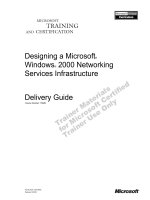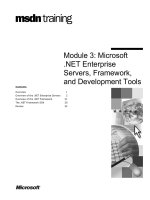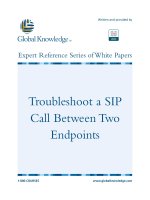Tài liệu DEPLOYING A FULLY ROUTED ENTERPRISE CAMPUS NETWORK docx
Bạn đang xem bản rút gọn của tài liệu. Xem và tải ngay bản đầy đủ của tài liệu tại đây (2.89 MB, 96 trang )
1
© 2005 Cisco Systems, Inc. All rights reserved.
RST-2031
11207_05_2005_c2
DEPLOYING A FULLY ROUTED
ENTERPRISE CAMPUS NETWORK
SESSION RST-2031
222
© 2005 Cisco Systems, Inc. All rights reserved.
RST-2031
11207_05_2005_c2
Agenda
• Campus Network Designs
• Routed Access Design
• EIGRP Design Details
• OSPF Design Details
• PIM Design Details
• Summary
333
© 2005 Cisco Systems, Inc. All rights reserved.
RST-2031
11207_05_2005_c2
Hierarchical Campus Design
Building Blocks
Data Center
WAN Internet
SiSi SiSi SiSi SiSi SiSi SiSi
SiSi
SiSi
SiSi
SiSi
SiSi
SiSi
SiSi
SiSi
Access
Distribution
Core
Distribution
Access
• Offers hierarchy—each layer has
specific role
• Modular topology—building blocks
• Easy to grow, understand, and
troubleshoot
• Creates small fault domains—clear
demarcations and isolation
• Promotes load balancing and
redundancy
• Promotes deterministic traffic patterns
• Incorporates balance of both Layer 2 and
Layer 3 technology, leveraging the
strength of both
• Can be applied to all campus designs;
multilayer L2/L3 and routed access
designs
444
© 2005 Cisco Systems, Inc. All rights reserved.
RST-2031
11207_05_2005_c2
Tried and True: Reference Design
Multilayer L2/L3 Design
• Consider fully utilizing uplinks via GLBP
• Distribution-to-distribution link required for route summarization
• No STP convergence required for uplink failure/recovery
• Map L2 VLAN number to L3 subnet for ease of use/management
• Can easily extend VLANs across access layer switches if required
10.1.20.0
10.1.120.0
VLAN 20 Data
VLAN 120 Voice
VLAN 40 Data
VLAN 140 Voice
10.1.40.0
10.1.140.0
HSRP or GLBP
VLANs 20,120,40,140
HSRP or GLBP
VLANs 20,120,40,140
Reference
Model
Layer 3
Si
SiSi
Si
Layer 2
Access
Distribution
555
© 2005 Cisco Systems, Inc. All rights reserved.
RST-2031
11207_05_2005_c2
Data Center
SiSi
SiSi
SiSi SiSi
SiSi
SiSi
Hierarchical Campus Design
Multilayer L2/L3 Building Blocks
• Highly available and fast—always on
• Deploy QoS end-to-end: protect the good and
punish the bad
• Equal cost core links provide for best
convergence
• Optimize CEF for best utilization of redundant
L3 paths
• Aggregation and policy enforcement
• Use HSRP or GLBP for default gateway protection
• Use Rapid PVST+ if you MUST have L2 loops in
your topology
• Keep your redundancy simple; deterministic
behavior = understanding failure scenarios and
why each link is needed
• Network trust boundary
• Use Rapid PVST+ on L2 ports to prevent loops in
the topology
• Use UDLD to protect against 1 way interface UP
connections
• Avoid daisy chaining access switches
• Avoid asymmetric routing and unicast flooding,
don’t span VLANS across the access layer
Access
Distribution
Core
Distribution
Access
666
© 2005 Cisco Systems, Inc. All rights reserved.
RST-2031
11207_05_2005_c2
Routing to the Edge
Layer 3 Distribution with Layer 3 Access
• Move the Layer 2/3 demarcation to the network edge
• Upstream convergence times triggered by hardware detection
of link lost from upstream neighbor
• Beneficial for the right environment
10.1.20.0
10.1.120.0
VLAN 20 Data
VLAN 120 Voice
VLAN 40 Data
VLAN 140 Voice
10.1.40.0
10.1.140.0
EIGRP/OSPF EIGRP/OSPF
GLBP Model
Si
Si
Si
Si
Layer 3
Layer 2
Layer 3
Layer 2
EIGRP/OSPF EIGRP/OSPF
777
© 2005 Cisco Systems, Inc. All rights reserved.
RST-2031
11207_05_2005_c2
Data Center
SiSi
SiSi
SiSi SiSi
SiSi
SiSi
Hierarchical Campus Design
Routed Access Building Blocks
• Highly available and fast—always on
• Deploy QoS end-to-end: protect the good and
punish the bad
• Equal cost core links provide for best
convergence
• Access layer aggregation
• Route summarization to the core to minimize
routing events
• Route filtering from the core to minimize routing
table size in access
• OSPF stub area border (ABR)
• Keep your redundancy simple; equal cost load
balancing between access and core
• Vary CEF algorithm to prevent polarization
• Network trust boundary
• VLANs are contained to the access switch
• Use EIGRP or OSPF on interfaces to
distribution layer
• Use parallel paths for Equal Cost Multi Path
(ECMP) routing
• Use EIGRP stub routers or OSPF stub areas to
limit scope of convergence events
Access
Distribution
Core
Distribution
Access
888
© 2005 Cisco Systems, Inc. All rights reserved.
RST-2031
11207_05_2005_c2
What Is High Availability?
DPM—Defects per Million
Availability Downtime Per Year (24x365)
99.000%
99.500%
99.900%
99.950%
99.990%
99.999%
99.9999%
3 Days
1 Day
53 Minutes
5 Minutes
30 Seconds
15 Hours
19 Hours
8 Hours
4 Hours
36 Minutes
48 Minutes
46 Minutes
23 Minutes
DPM
10000
5000
1000
500
100
10
1
“High
Availability”
999
© 2005 Cisco Systems, Inc. All rights reserved.
RST-2031
11207_05_2005_c2
What If You Could…
Reduce Cost Through Diminished Risk of Downtime
• Costs for downtime are high
One day cost of lost productivity =
$1,644 per employee
100 person office = $164K
per day
• More than just a data
network outage
• More than just revenue
impacted
Revenue loss
Productivity loss
Impaired financial performance
Damaged reputation
Recovery expenses
Source: Meta Group
999
$ 205$1,010,536Average
$ 107$ 668,586Transportation
$ 244$1,107,274Retail
$ 370$1,202,444Insurance
$1,079$1,495,134Financial Institution
$ 134$1,610,654Manufacturing
$ 186$2,066,245Telecommunications
$ 569$2,817,846Energy
Revenue/
Employee-
Hour
Revenue/HourIndustry Sector
101010
© 2005 Cisco Systems, Inc. All rights reserved.
RST-2031
11207_05_2005_c2
Campus High Availability
Sub-Second Convergence
Worst Case Convergence for Any Campus Failure Even
Seconds
0
0.2
0.4
0.6
0.8
1
1.2
1.4
1.6
1.8
2
L2 Access
OSPF Core*
L2 Access
EIGRP Core
OSPF
Access*
EIGRP
Access
L2 Access (Rapid PVST+ HSRP)
L3 Access
*OSPF Results Require Sub-Second Timers
111111
© 2005 Cisco Systems, Inc. All rights reserved.
RST-2031
11207_05_2005_c2
High-Availability Networking in the Campus
Reinforced Network Infrastructure:
Infrastructure Security Hardening
Device-Level and Software Resiliency
Real World Network Design:
Hierarchical Network Design—
Structured Modular Foundation
Network Operations:
Best Practices
Real-Time Network Management:
Best Practices
Best-in-Class Support:
TAC, CA, Etc.
121212
© 2005 Cisco Systems, Inc. All rights reserved.
RST-2031
11207_05_2005_c2
Routed Access Design
Structured Design Foundation
• EIGRP or OSPF routed links between access and distribution
• Routed interfaces, not VLAN trunks, between switches
• Equal cost multi path to load balance traffic across network
• Route summarization at distribution (like L2/L3)
• Single (IGP) control plane to configure/manage (no STP, HSRP,)
10.1.20.0
10.1.120.0
VLAN 20 Data
VLAN 120 Voice
VLAN 40 Data
VLAN 140 Voice
10.1.40.0
10.1.140.0
EIGRP or OSPF
Equal Cost Multi Path
Layer 2
Layer 3
Si
SiSi
Si
Si
SiSi
Si
Access
Distribution
131313
© 2005 Cisco Systems, Inc. All rights reserved.
RST-2031
11207_05_2005_c2
Agenda
• Campus Network Designs
• Routed Access Design
• EIGRP Design Details
• OSPF Design Details
• PIM Design Details
• Summary
141414
© 2005 Cisco Systems, Inc. All rights reserved.
RST-2031
11207_05_2005_c2
Why Routed Access Campus Design?
• Most Catalysts
®
support L3 switching today
• EIGRP/OSPF routing preference over spanning tree
• Single control plane and well known tool set
Traceroute, show ip route, sho ip eigrp neighbor, etc…
• IGP enhancements; stub router/area, fast reroute, etc..
• It is another design option available to you
Layer 2
Layer 3
Si
SiSi
Si
Si
SiSi
Si
Access
Distribution
151515
© 2005 Cisco Systems, Inc. All rights reserved.
RST-2031
11207_05_2005_c2
Ease of Implementation
• Less to get right:
No STP feature placement core
to distribution
LoopGuard
RootGuard
STP Root
No default gateway redundancy
setup/tuning
No matching of STP/HSRP/GLBP
priority
No L2/L3 multicast topology
inconsistencies
161616
© 2005 Cisco Systems, Inc. All rights reserved.
RST-2031
11207_05_2005_c2
Ease of Troubleshooting
• Routing troubleshooting tools
Show ip route
Traceroute
Ping and extended pings
Extensive protocol debugs
Consistent troubleshooting; access, dist, core
• Bridging troubleshooting tools
Show ARP
Show spanning-tree, standby, etc…
Multiple show CAM dynamic’s to find a host
• Failure differences
Routed topologies fail closed—i.e. neighbor loss
Layer 2 topologies fail open—i.e. broadcast and unknowns flooded
171717
© 2005 Cisco Systems, Inc. All rights reserved.
RST-2031
11207_05_2005_c2
Routing to the Edge
Advantages? Yes, in the Right Environment
• EIGRP and OSPF converge in <200 msec
• OSPF convergence times dependent on timer tuning
• RPVST+ convergence times dependent on GLBP/HSRP tuning
A B
Si
SiSi
Si
Si
SiSi
Si
0
0.2
0.4
0.6
0.8
1
1.2
1.4
1.6
1.8
2
RPVST+ OSPF EIGRP
Upstream
Downstream
Seconds
181818
© 2005 Cisco Systems, Inc. All rights reserved.
RST-2031
11207_05_2005_c2
Routed Access Considerations
• Do you have any Layer 2 VLAN adjacency
requirements between access switches?
• IP addressing—do you have enough address
space and the allocation plan to support a
routed access design?
• Platform requirements;
Catalyst 6500 requires an MSFC with hybrid (CatOS and Cisco IOS
®
) in the
access to get all the necessary switchport and routing features
Catalyst 4500 requires a SUP4 or higher for EIGRP or OSPF
Catalyst 3500s and 3700s require an enhanced Cisco IOS image for
EIGRP and OSPF
191919
© 2005 Cisco Systems, Inc. All rights reserved.
RST-2031
11207_05_2005_c2
Interior Gateway Protocol Options
Static Routing
• Benefits
Price; in default Cisco IOS feature set for routers and Layer 3 switches
• Considerations
Configuration intensive and prone to error
Potential routing black holes during some failure conditions
• Design guidance
Default route from the access to the distribution
Specific route from the distribution to the access
Set next-hop to neighbor’s adjacent IP interface address to minimize black
holes during failure conditions
Redistribute static routes from distribution to core—summarize access
subnets when possible
202020
© 2005 Cisco Systems, Inc. All rights reserved.
RST-2031
11207_05_2005_c2
Interior Gateway Protocol Options
RIP Routing
• Benefits
Widely supported
Price; in default Cisco IOS feature set of Catalyst L3 switches
• Considerations
Slow convergence time
Limited network diameter; max hops = 16
Redistributing into an advanced IGP?
• Design guidance
Use RIP version two; VLSM
Tune hellos down to one second
Summarize routes from distribution to core
Use routed interfaces vs. VLAN trunks
212121
© 2005 Cisco Systems, Inc. All rights reserved.
RST-2031
11207_05_2005_c2
Interior Gateway Protocol Options
EIGRP Routing
• Benefits
Simple to configure
Extremely fast convergence without tuning
Scales to large topologies
Flexible topology options
• Considerations
Cisco innovation
Summarization to limit query range
Price; requires enhanced IOS image in some Catalysts
• Design guidance
Later in the presentation
222222
© 2005 Cisco Systems, Inc. All rights reserved.
RST-2031
11207_05_2005_c2
Interior Gateway Protocol Options
OSPF Routing
• Benefits
Fast convergence with tuning
Widely deployed industry standard
• Considerations
Design and configuration complexity
Price; requires enhanced IOS image in most Catalysts
Topology design restrictions
• Design guidance
Later in the presentation
232323
© 2005 Cisco Systems, Inc. All rights reserved.
RST-2031
11207_05_2005_c2
EIGRP vs. OSPF as Your Campus IGP
DUAL vs. Dijkstra
• Convergence:
Within the campus environment,
both EIGRP and OSPF provide
extremely fast convergence
EIGRP requires summarization
OSPF requires summarization and
timer tuning for fast convergence
• Flexibility:
EIGRP supports multiple levels of
route summarization and route
filtering which simplifies migration
from the traditional multilayer L2/L3
campus design
OSPF area design restrictions need
to be considered
• Scalability:
Both protocols can scale to support
very large enterprise network
topologies
0
0.2
0.4
0.6
0.8
1
1.2
1.4
1.6
1.8
2
OSPF OPSF 12.2S EIGRP
Upstream
Downstream
242424
© 2005 Cisco Systems, Inc. All rights reserved.
RST-2031
11207_05_2005_c2
CEF Load Balancing
Avoid Underutilizing Redundant Layer 3 Paths
• The default CEF hash
‘input’ is L3
• CEF polarization: In a multi-
hop design, CEF could
select the same left/left or
right/right path
• Imbalance/overload
could occur
• Redundant paths are
ignored/underutilized
Redundant
Paths
Ignored
Si
SiSi
Si
Si
Si
Si
Si
Si
Si
Si
Si
L
L
R
R
Distribution
Default L3 Hash
Core
Default L3 Hash
Distribution
Default L3 Hash
Access
Default L3 Hash
Access
Default L3 Hash
252525
© 2005 Cisco Systems, Inc. All rights reserved.
RST-2031
11207_05_2005_c2
CEF Load Balancing
Avoid Underutilizing Redundant Layer 3 Paths
• With defaults, CEF could select
the same left/left or right/right
paths and ignore some redundant
paths
• Alternating L3/L4 hash and
default L3 hash will give us
the best load balancing results
• The default is L3 hash—no
modification required in core or
access
• In the distribution switches
use:
mls ip cef load-sharing full
to achieve better redundant path
utilization
Si
SiSi
Si
Si
Si
Si
Si
Si
Si
Si
Si
RL
R
Distribution
L3/L4 Hash
Core
Default L3 Hash
Distribution
L3/L4 Hash
L
RL
Left Side
Shown
Access
Default L3 Hash
Access
Default L3 Hash
L
All Paths
Used
Note: Catalyst 6500 SUP720 does not require CEF tuning









